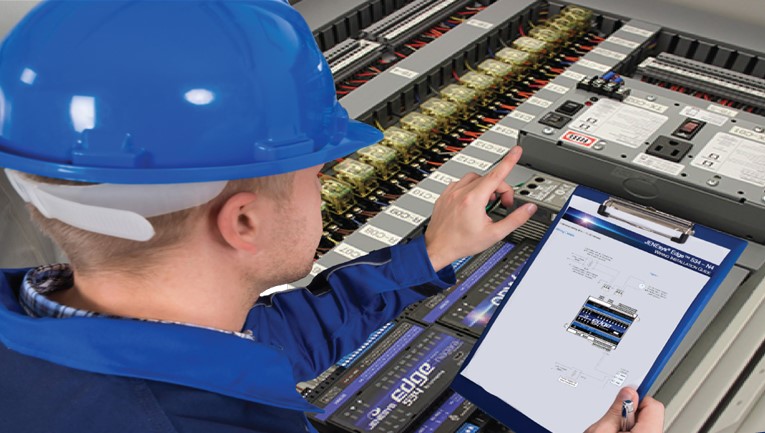by Marc Petock, VP, Chief Marketing & Communications Officer, Lynxspring, founding member of Project Haystack — What if your building automation and integration decisions were managed with the same precision, discipline and long-term vision as Warren Buffett’s investment portfolio? Imagine being the leader in your organization that people refer to as “the Warren Buffett of Building Automation,” someone whose decisions consistently deliver value, resilience, and competitive advantage — not just for today, but for years to come.

What if your building automation and integration decisions were managed with the same precision, discipline and long-term vision as Warren Buffett’s investment portfolio? Image courtesy of Lynxspring
The problem is most companies don’t treat building automation this way. They approach it as a necessary expense, focusing on immediate operational needs, short-term projects and the latest shiny platforms, without a cohesive strategy. This mindset turns automation into an endless series of costs, instead of what it truly can be: a powerful investment designed to compound operational and business value over time.
To change this narrative, we need to reframe how we think about building automation. What if we managed it like Berkshire Hathaway manages its investments? What would it take to build an automation and integration portfolio that not only supports business operations but drives them forward with the same clarity, confidence, and long-term payoff as Buffett’s legendary stock picks? Let’s break it down.
The core philosophy: Building automation as an investment, not an expense
At the heart of Buffett’s success is a simple philosophy: focus on intrinsic value, invest with a long-term horizon, and avoid unnecessary risks. This approach isn’t just for Wall Street; it’s equally powerful in the world of building automation and integration.
Most organizations treat automation as a utility implemented to meet a baseline need, with the primary goal of keeping costs low. But that’s like building a financial portfolio by simply buying the cheapest stocks available. It’s reactive, shortsighted and often expensive in the long run due to inefficiencies, integration challenges and missed opportunities.
Now flip that mindset. Imagine treating every automation and integration decision as if it were an investment with the potential to either compound value or drain resources over time. Instead of asking, “How much does this cost?” start asking, “What’s the long-term return on this investment?” This shift in thinking creates discipline, clarity and purpose. It forces leaders to evaluate automation not just for its features or price tag, but for its strategic fit, scalability, and impact on operational and business goals.
Applying Buffett’s principles to building automation
Warren Buffett’s investment principles aren’t complicated, but their simplicity hides profound wisdom. When applied to automation, they create a framework for making smarter, more strategic decisions.
-

Imagine treating every automation and integration decision as if it were an investment with the potential to either compound value or drain resources over time. Image courtesy of Lynxspring
Value over price — Buffett famously said, “Price is what you pay; value is what you get.” In building automation, it’s easy to chase the cheapest solution or the flashiest new platform. But the real question is: what value will this technology deliver over time? A higher upfront cost might yield greater long-term efficiency, scalability, and security — delivering a better return than a cheaper alternative that becomes obsolete or requires constant workarounds.
- Circle of competence — Buffett only invests in businesses he understands deeply. Similarly, companies need to make automation decisions within their “circle of competence.” This doesn’t mean avoiding innovation, but it does mean ensuring that decisions are informed by a clear understanding of how technology fits into the broader operational and business strategy. Too often, organizations invest in platforms they don’t fully understand, leading to poor adoption, misalignment, wasted resources and the lack of delivering outcomes.
- Margin of safety — Buffett always looks for a margin of safety — an investment buffer that protects against unforeseen risks. In automation, this translates to resilience. Are your systems designed with redundancy? Is your cybersecurity posture strong enough to withstand unexpected threats? Do you have backup strategies for critical operations? A well-managed automation portfolio isn’t just about efficiency; it’s about durability in the face of uncertainty.
- Long-term thinking — Perhaps Buffett’s most defining characteristic is his patience. He invests for the long haul, ignoring short-term market noise. In building automation, this means resisting the temptation of quick fixes that don’t align with the company’s strategic goals. It’s easy to get excited about the latest platform, but does it support where the business wants to be in five or ten years? Sustainable growth comes from technologies that integrate, scale, and adapt over time — not from chasing every trend.
Becoming the “Warren Buffett of Building Automation” in your organization
So, what does it take to earn that title — the person whose automation and integration decisions are as trusted and respected as Buffett’s investment calls?
- Clarity in decision-making is key. Just as Buffett has an investment thesis for every stock he buys, building automation leaders should have a clear rationale for every major technology decision. What problem does it solve? How does it align with business goals? What outcomes do I want to achieve? What’s the expected return on investment — not just financially, but in terms of operational efficiency, sustainability, and scalability?
- Patience and discipline are equally important. In the fast-paced world of building technology, it’s easy to feel pressured to act quickly. But speed without strategy leads to mistakes. The best automation leaders know when to move fast and when to pause, assess and make deliberate choices.
- Data-driven judgments separate great leaders from average ones. Buffett doesn’t invest based on hype; he relies on data, analysis and rigorous evaluation. In automation, this means leveraging performance metrics, energy usage trends, cost efficiency and business impact to guide decisions.
- Decisive allocation is crucial. Not every technology deserves equal attention or investment. Great building automation leaders know where to double down — investing heavily in platforms that drive efficiency and adaptability — and where to cut losses on underperforming systems. Just like managing a financial portfolio, the goal is to maximize returns while minimizing waste.
Managing risk like a pro: The Berkshire Playbook for building automation
Buffett doesn’t fear risk; he manages it. He avoids unnecessary risks while embracing calculated ones that offer strong potential rewards. This mindset applies perfectly to automation, where risk management isn’t just about cybersecurity, it’s about operational resilience.

The goal is to build automation systems that are as robust and adaptable as a well-diversified investment portfolio. Image courtesy of Lynxspring
For example, consider vendor risk. Many companies become overly reliant on a single provider without considering the long-term implications. What happens if that vendor’s pricing model changes, their service quality drops, or they go out of business? A Buffett-style approach diversifies dependencies without creating unnecessary complexity.
The same goes for technical debt. Just as Buffett avoids companies with poor financial fundamentals, smart automation leaders avoid solutions that are fragile, overcomplicated, or unsustainable. The goal is to build systems that are as robust and adaptable as a well-diversified investment portfolio.
Are you managing automation like Warren Buffett would?
If you’re serious about transforming how your organization approaches building automation, ask yourself:
- Do you have a clear, strategic rationale behind your major automation investments?
- Are your decisions driven by long-term value, not just short-term fixes?
- Is your automation portfolio resilient, adaptable, and aligned with your business goals?
- Are you actively managing risks — or just hoping things won’t go wrong?
If the answer to any of these questions is “no,” it’s time to rethink your approach.
The legacy of strategic building automation leadership
Becoming the Warren Buffett of building automation isn’t about being the smartest person in the room. It’s about being the most disciplined, strategic, and focused on long-term outcomes. Because in the end, great automation leadership isn’t about technology, it’s about creating lasting business value.
So, the next time you’re faced with an automation decision, ask yourself: “Am I managing this like an expense — or like an investment that will shape the future of this company?”
 Marc Petock is a recognized thought leader and pioneer in intelligent buildings and smart technology space with decades of experience driving innovation in building automation, integration, IoT, and data-driven technology and solutions. As an industry advocate, he frequently speaks and writes on the convergence of technology and building performance, helping shape the future of smart, connected environments. He currently is Vice President, Chief Marketing & Communications Officer at Lynxspring and is a founding member and serves on the Board of Directors for Project Haystack.
Marc Petock is a recognized thought leader and pioneer in intelligent buildings and smart technology space with decades of experience driving innovation in building automation, integration, IoT, and data-driven technology and solutions. As an industry advocate, he frequently speaks and writes on the convergence of technology and building performance, helping shape the future of smart, connected environments. He currently is Vice President, Chief Marketing & Communications Officer at Lynxspring and is a founding member and serves on the Board of Directors for Project Haystack.